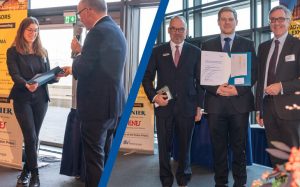 AACHEN, Germany — December 11, 2023 — The Institut für Textiltechnik (ITA) of RWTH Aachen University can look forward to two award winners in 2023: In his master’s thesis, ITA master’s graduate student Flávio André Marter Diniz developed polyethylene (PE)-based carbon fibers that are two to three times thinner than usual and showed how the use of PE-based precursors can reduce the price of carbon fibers by 50 percent in the future. For his master’s thesis “Investigation of the stabilisation and carbonisation process for the production of ultra-thin polyethylene-based carbon fibres”, he was awarded the prize for the best diploma/master’s thesis in German textile mechanical engineering and prize money of 3,500 euros.
AACHEN, Germany — December 11, 2023 — The Institut für Textiltechnik (ITA) of RWTH Aachen University can look forward to two award winners in 2023: In his master’s thesis, ITA master’s graduate student Flávio André Marter Diniz developed polyethylene (PE)-based carbon fibers that are two to three times thinner than usual and showed how the use of PE-based precursors can reduce the price of carbon fibers by 50 percent in the future. For his master’s thesis “Investigation of the stabilisation and carbonisation process for the production of ultra-thin polyethylene-based carbon fibres”, he was awarded the prize for the best diploma/master’s thesis in German textile mechanical engineering and prize money of 3,500 euros.

In her Bachelor’s thesis, ITA Bachelor’s graduate Annika Datko showed how used textiles can be sorted by fibre composition using near-infrared (NIR) sensor technology and, on a laboratory scale, has an average mean error of only 4 percent. Sorting according to fiber composition to subsequently carry out fiber-to-fiber recycling is the most sustainable way to produce new fibres for new products from (used) textile fibers. For her work “Experimental analysis of the sortability of used textiles containing polyester using near-infrared spectroscopy on a laboratory and industrial scale”, she received the 3,000 euros prize for the best bachelor’s thesis from the German Textile Machinery Association.
The chairman of the Board of the Walter Reiners Foundation, Peter D. Dornier, presented the prizes at the Aachen-Dresden-Denkendort International Textile Conference in Dresden.
New manufacturing approach for more cost-effective carbon fibers
Carbon fibers are often used in growth areas such as wind turbines and pressure tanks due to their excellent properties. Unfortunately, they are very expensive due to high manufacturing costs and are not available in sufficient quantities. In his master’s thesis, Marter Diniz developed a new and cost effective manufacturing process by producing low-cost carbon fibers using a polyethylene precursor. Further advantages: the carbon fibers have an excellent surface quality without any noticeable structural deficits. In addition, Marter Diniz was able to reduce the time consuming sulphonation process by 25 percent.
These major advantages pave the way for a wider range of applications for carbon fibers in key industries such as wind power, automotive and aerospace.
New method for fiber-to-fiber recycling of used textiles can revolutionize textile recycling
Used textiles are currently sorted almost exclusively by hand. For fiber-to-fiber recycling — currently the most sustainable textile recycling option — it is important to sort textiles by fiber composition. This can-not be reliably done manually, i.e. by feel, especially with fiber blends. Annika Datko’s approach of using NIR for sorting used textiles is new. NIR sensor technology is already state of the art for recycling plastic waste, but is still in its infancy when it comes to sorting textiles.
How exactly it works: The textile sample is irradiated with NIR light. Based on the wavelengths of the reflected light and the light picked up by the detector, a material-specific spectrum is created that resembles a fingerprint. In her bachelor’s thesis, Annika Datko com-pared these spectra or fingerprints of textiles with different fiber components. She was able to prove that it is possible to differentiate between different fiber compositions using NIR and that it has a very low average mean error of just 4 percent on a laboratory scale.
Posted: December 11, 2023
Source: ITA – Institut für Textiltechnik of RWTH Aachen University




